The Military's Fitness Culture Is Broken. SOFLETE Wants to Fix It.
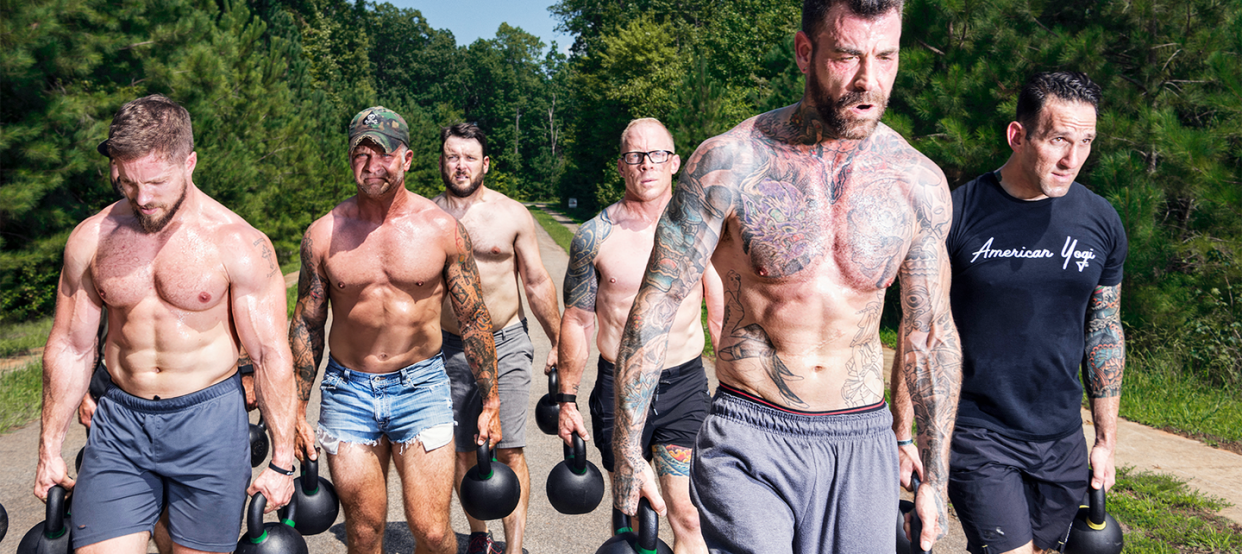
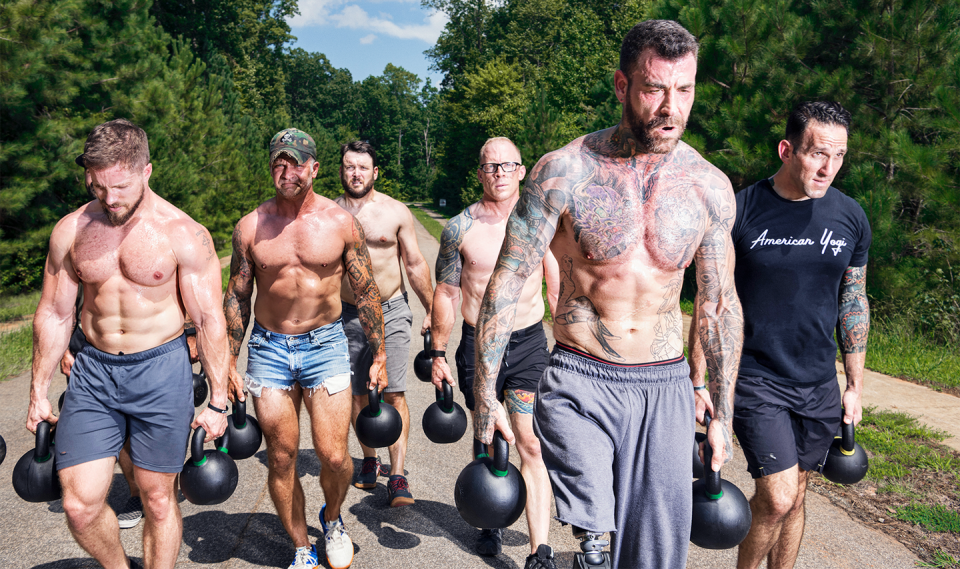
DAWN'S RAYS ARE creeping west across the Mojave, crawling up Joshua trees and barrel cacti, as a group of U. S. Special Operations warriors sit cross-legged, all lined up and scanning the dry horizon. These exquisitely tattooed, overmuscled rogues have descended upon this desert from across the nation. Alongside them are a handful of first responders and a few civilians. Chests slowly rise and fall as each person inhales and exhales the cool, dry air. One among their ranks breaks the silence. “Ready?” asks Alex Horton, a commander in the Joint Special Operations Command. All nod.
I’m there anticipating some reenactment of Desert Storm. But what I get is closer to Desert Om. “Close your eyes to begin this meditation,” Horton says. “I want you to focus on the sensation of the breath. When thoughts arise, notice them without judgment.” And then she occasionally reminds the group to “feel the breath” or “notice and let go,” until after 15 minutes she announces, “Time’s up.”
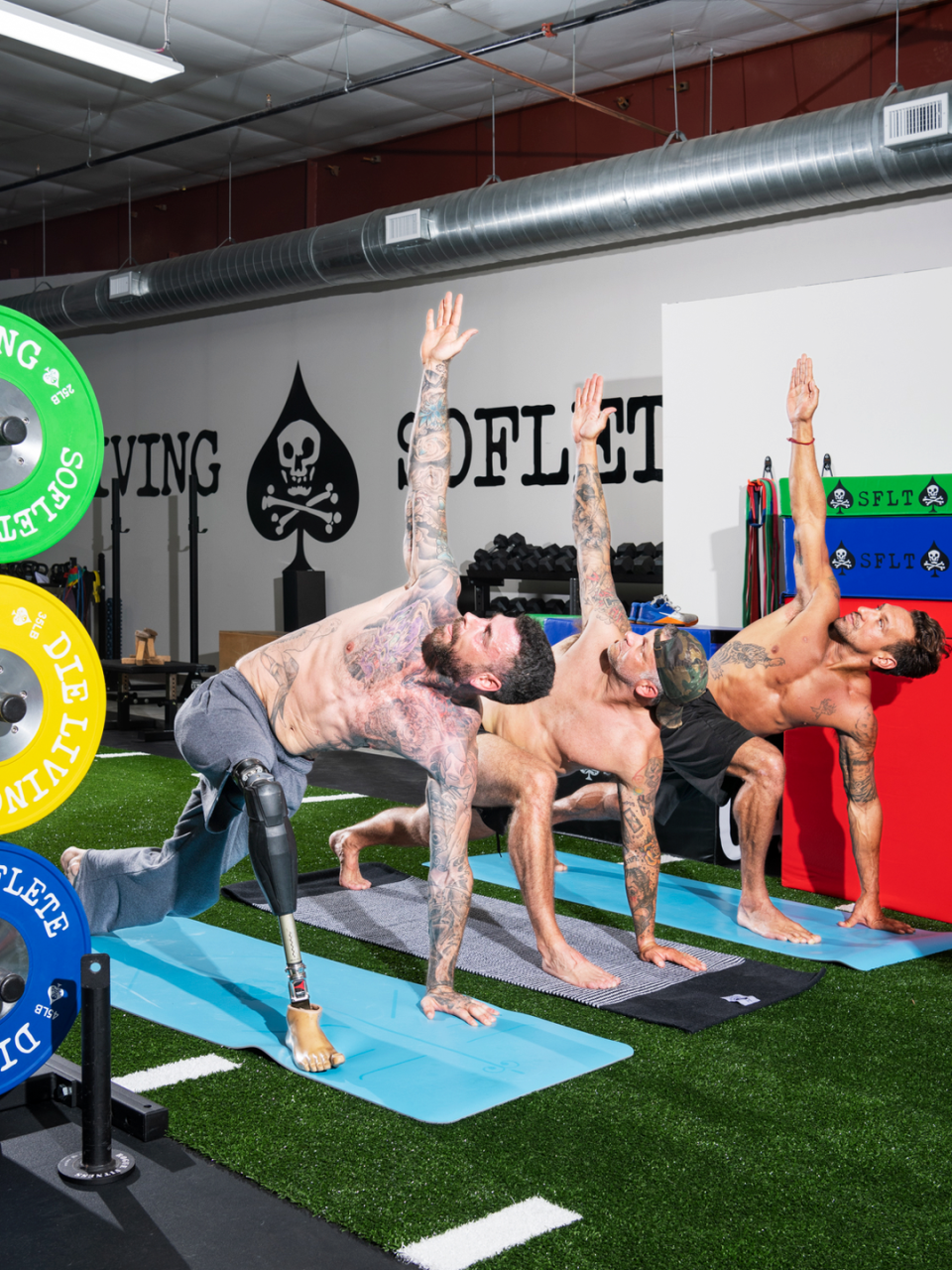
We’re at a weekend retreat held by SOFLETE, a fitness-content company owned by Special Operations personnel that isn’t following the long-held narrative of how people in the military, first responders, and other active men and women should train, live, and do their jobs. Army Rangers and Green Berets, Marines, firefighters, police, and SWAT members, along with an accountant, an electrical lineman, a roughneck, and others: Most of the 25 people here have taken lives, saved lives, and undoubtedly seen some shit. Together this group is seeking something like enlightenment: zenning out, exploring the psychedelic landscape of Joshua Tree National Park, and speaking the capital-T truth about the state of being an elite serviceman or -woman in 2019.
Each of them landed in the Mojave after a bout of burnout—from too many stressful deployments or hours on duty or patrol; from military-style beatdown workouts and the nagging injuries that ensued; from the idea that those who keep us safe, or even civilians simply interested in military culture, must be part of a stoic, tougher-than-thou caste. The SOFLETE peeps are here doing something about that burnout. But they also know that the feeling extends far beyond the Mojave. Which is why they’re also scaling up their efforts on various media channels and through a training app—to bring the next generation of Special Operations training and tactical thinking to the masses.

CALL IT THE military-fitness complex—and it’s now at industrial scale. It’s the thousands of books, podcast episodes, Instagram feeds, seminars, and fitness programs that promise to reveal the physical and mental magic that makes Special Operations warriors so tough. The space is dominated by testosterone-emboldened vets and brands whose messages are basically this: The answer to all your problems is to adopt a military mind-set, or “mental toughness,” which is loosely translated as grinding harder and longer than the next guy and never quitting or showing weakness.
There is, for instance, David Goggins, a retired Navy SEAL and ultra-endurance athlete who has roughly 2 million Instagram followers. A typical post features the participation-
trophy-hating Goggins running while shouting into the camera about how growth requires suffering. He rails against “soft bullshit” like feeling pain, not exercising hard enough, and quitting. In his best-selling book, Can’t Hurt Me, Goggins brags about breaking fellow SEALs with workouts that were “punishing physically” and how he would “lose all respect” for the men who questioned the efficacy of those injurious sessions. He thinks a lot of people are “fucking pussies.” Or there’s Jocko Willink, a retired SEAL with some 850,000 Instagram followers as well as a popular podcast and books, who regularly posts photos of his 4:30 a.m. wakeup times, plus black-and-white shots of sweat puddles, overloaded barbells, and massive kettlebells, with captions like “The Altar of Pain,” “Blunt force trauma,” and “Torture with [insert weight].”
Then you’ve got groups of ex–Special Ops guys who host events that allow the average man to experience the hell of Hell Week. An event put on by SEALFit called Kokoro, for example, bills itself as the “premier training event for forging mental toughness.” About $2,500 buys you a 50-hour Hell Week physical and emotional thrashing that, like one of New York’s hottest clubs in a deranged Stefon skit on Saturday Night Live, “has everything”: multiple ice baths, group log carries, heavy rucking, the CrossFit workout Murph, calisthenics in the frigid Pacific Ocean, and more!
If Instagram comment sections are a reliable measure, these messages and events seem to have motivated a wave of sedentary guys to get off the couch. Which is undoubtedly a good thing, what with 72 percent of Americans now overweight or obese. And they’ve helped guys with soul-sucking office jobs find meaning by letting them feel the often-unknown bodily sensations—like cold, exhaustion, hunger, and pain—that lie beyond a comfort zone.
“There are plenty of companies out there who do hard for hard’s sake,” says George Briones, 31, a Marine recon operator and a SOFLETE employee. “That’s not what we do. We’re often working against that mind-set. Most [military personnel] push too hard and work through an injury and make it worse.”
As more troops and first responders have adopted these hard-line training and mind-set tactics, more and more of them have become mentally and physically beaten up and broken down. That can put them and their teams in dangerous positions, or just ruin their ability to live a healthy civilian life. The U. S. Army has publicly stated that injuries are “a modern military epidemic,” and a study funded by the U.S. Army Research Laboratory discovered that about 20 percent of its Spec Ops soldiers each year experience injuries that require medical attention. For every 100 soldiers, there are 25 annual injuries. The top cause of those injuries? Not bullets or IEDs. Exercise. Going too hard, too often. Team workouts consisting of ten-mile hikes while wearing 60-pound packs, followed by more pushups, situps, and flutter kicks than you can count, followed by whatever else a soldier does on his own in the gym, be it CrossFit, ultrarunning, or bodybuilding. In fact, the researchers say, 77 percent of these injuries could be avoided with improved injury-prevention programs.
Another problem, says Briones, is that many Special Operations guys are “either bodybuilders, bodyweight ninjas, or pure endurance athletes.” They’re fitness specialists in a job that requires strength, speed, stamina, and mobility—the capacity to drag a 200-plus-pound fallen comrade in full gear, sprint for cover during a firefight, ruck through the mountains to a mission point, or hold a covered-but-contorted shooting position in a sniper nest.
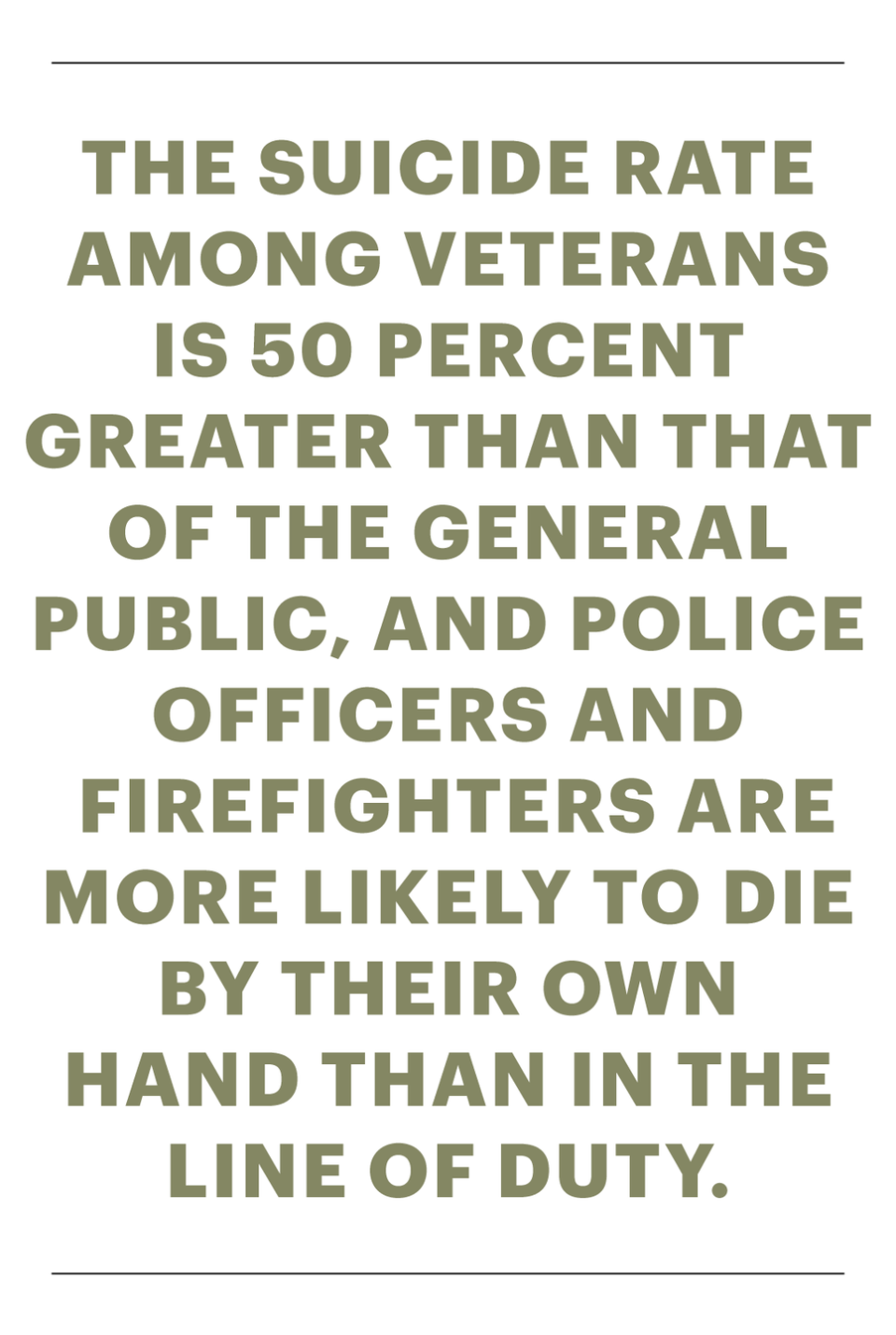
The military branches are fully aware that the way their personnel train isn’t exactly optimal. And they’re working on it—with varying degrees of success. The Army says it’s on a bold mission to change its “culture of fitness” so that training transfers to combat more effectively, reduces the risk of injury, and improves soldier readiness and resiliency. Major General Lonnie Hibbard, who commands the U. S. Army Center for Initial Military Training, calls it “holistic health and fitness.” It’s loosely described as physical fitness and performance enhancement, but also mental and spiritual fitness.
But whether the plan will make it out of the bureaucratic swamp and onto bases—and then survive there—is anyone’s guess. In 2009, for instance, U. S. Special Operations Command funded the Army’s creation of Thor3, a fitness program with its own facilities staffed by physical therapists, strength and conditioning coaches (poached from Team USA and elite sports programs), and sports nutritionists. It focused on optimizing the physical and mental conditioning of Special Forces operators and helping injured ones recover. It worked when it was implemented, improving fitness and reducing injuries, but it was slowly defunded and often neglected by untrained team leaders who didn’t realize its value.
You also have the unseen scars, of course. The suicide rate among veterans is 50 percent greater than that of the general public, and police officers and firefighters are more likely to die by their own hand than in the line of duty. The New York Times recently reported that more than 45,000 veterans and active-duty service members have killed themselves in the past six years. That is more than 20 deaths a day—in other words, more suicides each year than the total American military deaths in Afghanistan and Iraq.
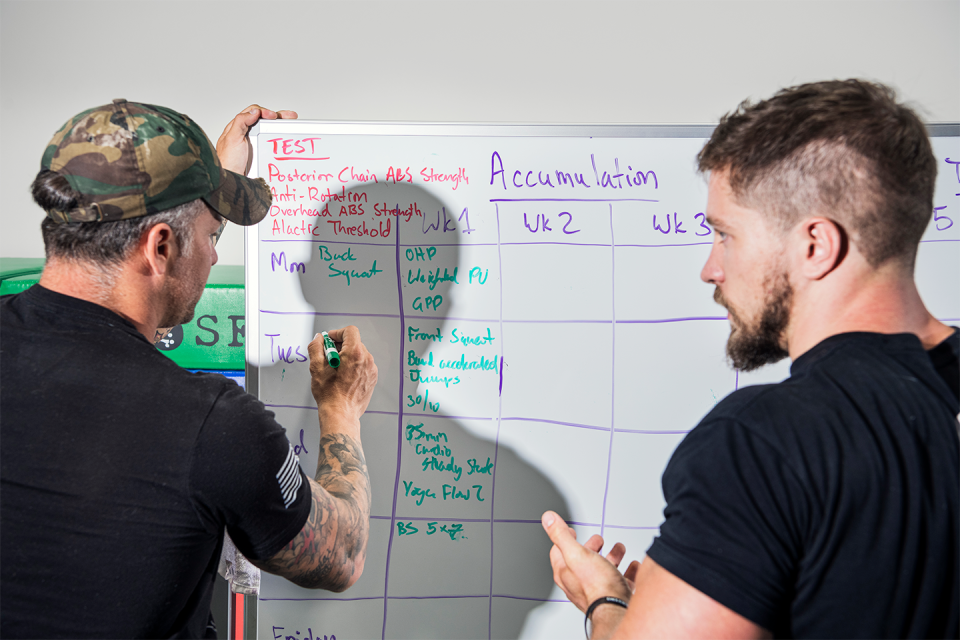
Mental toughness isn’t just doing more reps or miles than the next guy or getting through a selection course; it’s using smarter-not-harder approaches to fitness, even if that means you won’t be the strongest, fastest, fittest-looking guy in the gym. It’s knowing when to back down and take a day to take care of yourself. It’s checking your intentions, and even asking for help and recognizing your vulnerability. As the branches slowly trudge forward—the new fitness assessment test, for example, has been in the works for years and won’t be ready for rollout until late 2020—SOFLETE is filling a gap.
Now heavily meditated, the group rises from the seated position. Next up at the Mojave retreat: yoga. Nope, these SOFLETE dudes are not what you might expect from top military personnel. “Surfers, hippies, hipsters, and snowflakes . . . who also happen to have body counts” is how they describe themselves. But they may be onto something. The company began in 2015 with the intention of providing fitness programming exclusively for Special Operations guys. For them, the stakes of “military fitness” are much higher than looking cool on the ’Gram. The wrong fitness program can prevent servicemen and -women from advancing past a Special Ops selection course, stalling their career, or, even worse, put them in harm’s way on the battlefield.
SOFLETE is rethinking warrior fitness with sane fitness programming served with a side of woo, which just may be what military men and women need to be better at their jobs. “Yeah, I meditate. Yes, I do yoga. Yes, I do all these things that some people may associate with femininity or something,” says Brian Hueske, 38, a career Green Beret who’s built like a grizzly bear and who now also works for SOFLETE. “But I’m doing this stuff to maintain performance. At the end of the day, I’m doing this stuff because it makes me better at killing bad people.”
Modern-day Rambos with a softer side and no pretension to badassery? Could my experience in the desert have all been some strange hallucination? I needed to find out.

AND SO IT is that a few weeks later I find myself at SOFLETE headquarters in Durham, North Carolina. In the desert, I saw the restorative side of SOFLETE. Now I’m about to experience how the company builds elite war fighters and glean insights into its special marketing sauce that’s part rah-rah inspiration, part parody of bro science. That it took just four years for the company to go from a single workout shared by PDF to a 6,000-square-foot building and a reach of 2.5 million people each month speaks to the efficacy of SOFLETE’s workouts and the thirst for military-themed merch.
There are eight of us performing a mobility warmup on the 50-foot strip of turf that runs through SOFLETE HQ, which is part no-expenses-spared CrossFit-style gym, part content-creation studio, and part office. By the 2010s, the SOFLETE brain trust had started to realize that the message of the military-fitness complex was all wrong. Between deployments, each of them was running an elite gym, all looking for the fitness sweet spot where a warrior is optimized to perform—at a moment’s notice, over an entire career. “Special Operations guys never know when they’re going to have to go on a mission,” says Doug Kiesewetter, 38, an Army Special Forces weapons sergeant and partner at SOFLETE. “Any day could be the Super Bowl.” So imagine Tom Brady doing a burner workout and endless miles of rucking with an 80-pound pack every day leading up to the Super Bowl. How would he play? Not great, right? But that’s essentially what many other military-
fitness companies were and still are asking from their users.
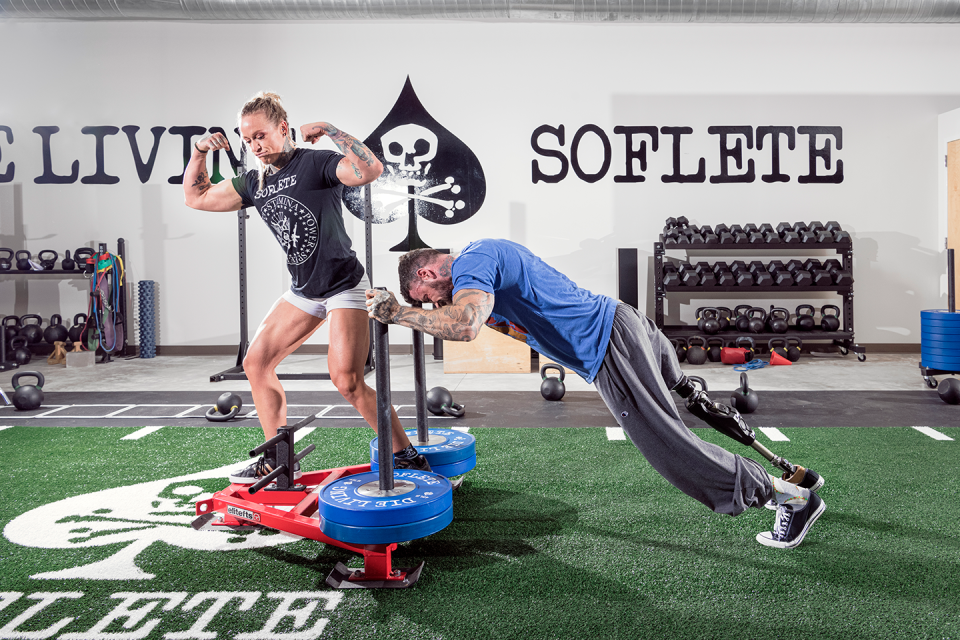
“In 2011, I’d spent the year doing a popular military athlete program,” says Hueske as he adjusts the settings on a camera he’ll use to capture video that SOFLETE will post to its social-media channels and website, dieliving.com. The site covers fitnessy topics like how to avoid boot-camp injuries and how to eat for performance, as well as mind-set stuff like dealing with failure, the trials of coming home from deployment, and grappling with the “badass” identity that society forces on military guys. “Every day, I’d do an hour of 80-pound sandbag Turkish getups, followed by these crazy high-intensity workouts. I always felt crushed, but that’s what I was told would work.” It didn’t.
“We had a training mission to raid an enemy compound, and to do that we had to climb up this huge hill in full kit with all of our breaching equipment, which is like 90 or 100 pounds of gear,” he says. “By the time we reached the top, I was smoked—and the actual mission hadn’t even started.”
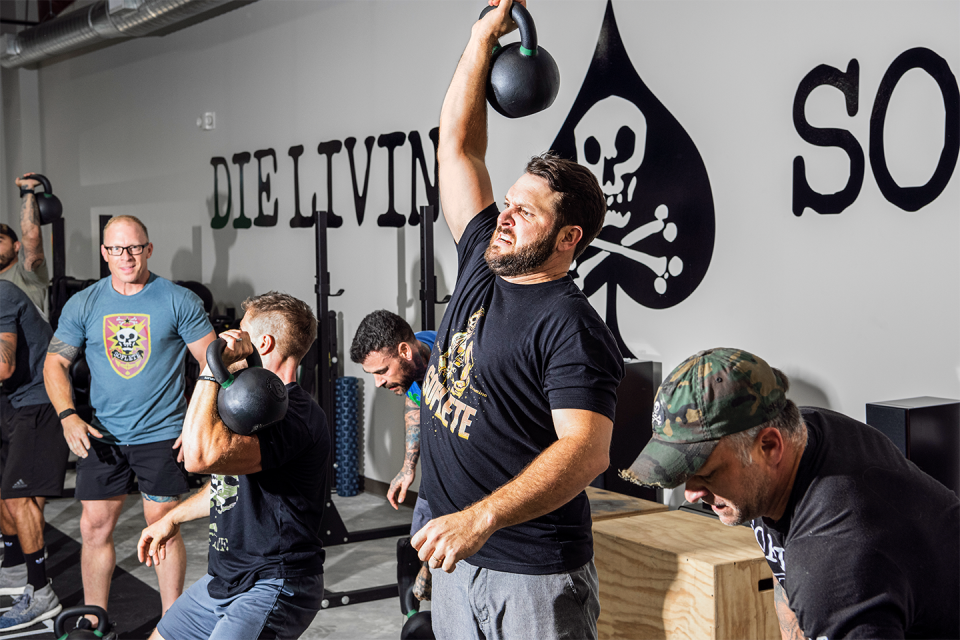
For someone like a pro CrossFit athlete—who can eat perfectly, sleep eight hours a night, get massages, and all that—regular all-in workouts can be effective. But military guys typically eat shitty food, get shitty sleep, and have shitty access to recovery practices (no ice baths in Tora Bora). Pounding away at balls-to-the-wall workouts eventually hurt Hueske’s back. “So then I was forced to recover,” he says while snapping photos of the group performing the warmup routine that will mobilize our legs, hips, and shoulders, three areas that military personnel commonly injure. During Hueske’s rehab, a colleague called him aside and, in the furtive tone you might use when confessing to another man that you like to sing along to Taylor Swift when you’re driving to work, said, “This training you’re doing . . . I know you think it’s cool, but you’re totally wrong. Here’s what you need to do. . . .”
The guy began explaining that “how hard you’re dragging your skull across the dirt does not correlate with a workout’s efficacy,” says Hueske. It only sets you up for injury and crap performance. A military strength coach gave him some programming that ticked a lot of fitness boxes and pushed Hueske’s limits but also stressed recovery and improving his mobility. “I was working out less,” Hueske says. “I felt like I was sandbagging, but I stayed the course.”
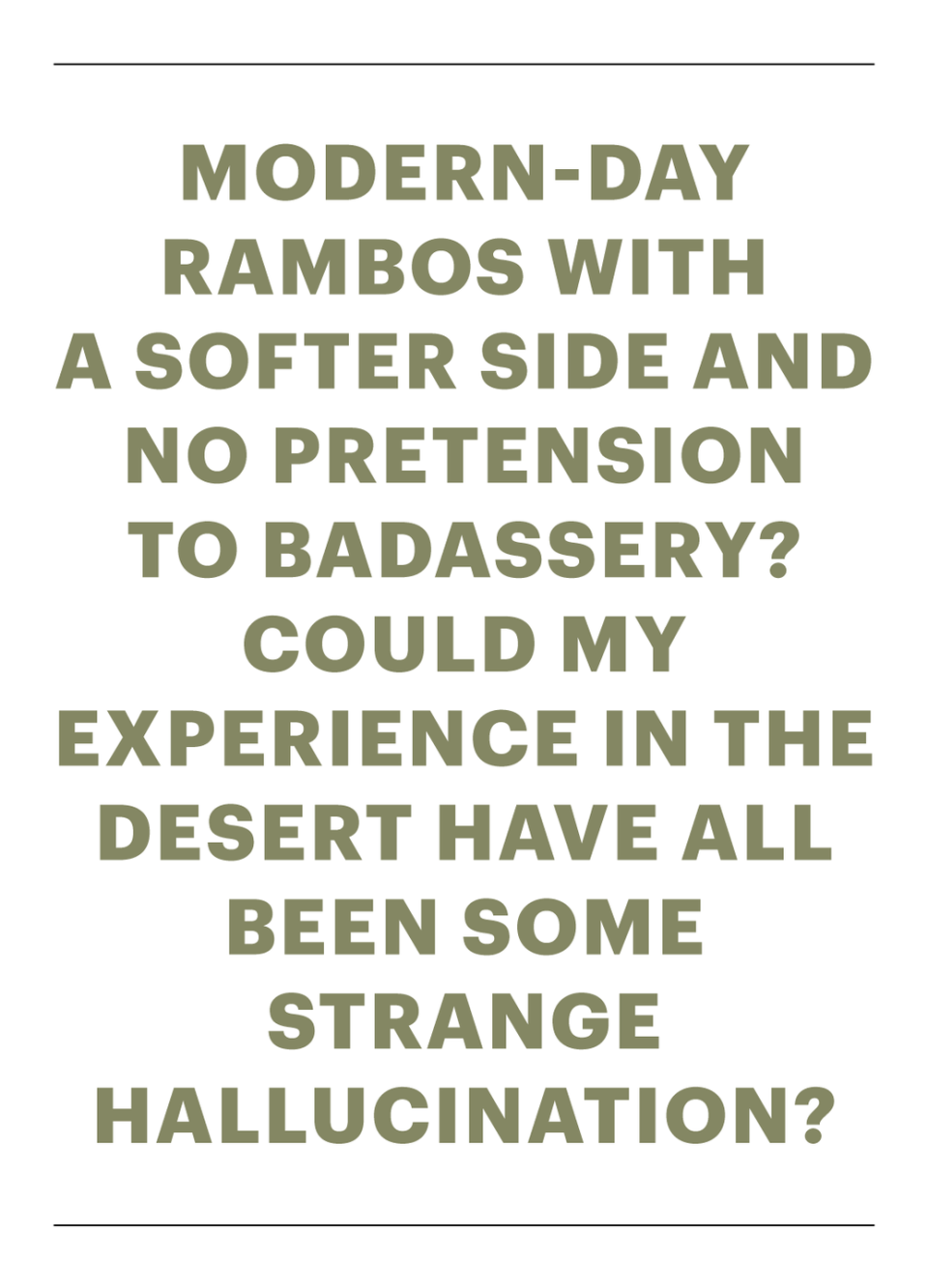
Soon after, he was sent on another training mission. “It was a six- or seven-hour infiltration where we were carrying heavy gear through the woods slowly and deliberately,” he says. “When we arrived at our destination to start the mission, I still had 95 percent left in the tank.” It was a meathead revelation. The other SOFLETE guys had similar come-to-fitness-Jesus moments. Briones was once involved in a four-hour firefight in Afghanistan when a burned-out team member went down with heatstroke in hour three, putting the entire team in danger as they tried to evacuate him.
“I watched my peers break themselves from overtraining and spend years trying to rehab while still needing to go to war,” says Kiesewetter. Running patrols in Afghanistan and Iraq, they’d walk with a hitch in their step, fail to turn on speed and power when they needed it most, and just generally move like dudes a decade older. Christian Hines, the SOFLETE employee who models many of the exercises in the app and who came from the Army’s 82nd Airborne, watched as many of his teammates were removed from their daily duties and training because they injured themselves trying to one-up the next guy in some timed workout or deadlifting session.
Now warmed up, we’re moving on to a strength phase. We’ll do three sets each of back squats, box jumps, and bench presses. The squat-and-jump combo leverages a phenomenon called post-activation potentiation, which research shows may give you a boost in strength and power.
Two of the cofounders of SOFLETE, whom we’ll call Bill and Greg (they wished not to be named due to their roles in the military), saw the same issue of overkill. “The original idea for SOFLETE was inspired by a peer of mine,” says Greg. “He was perpetually hurt from military fitness programs, which is so common among SOF guys.”
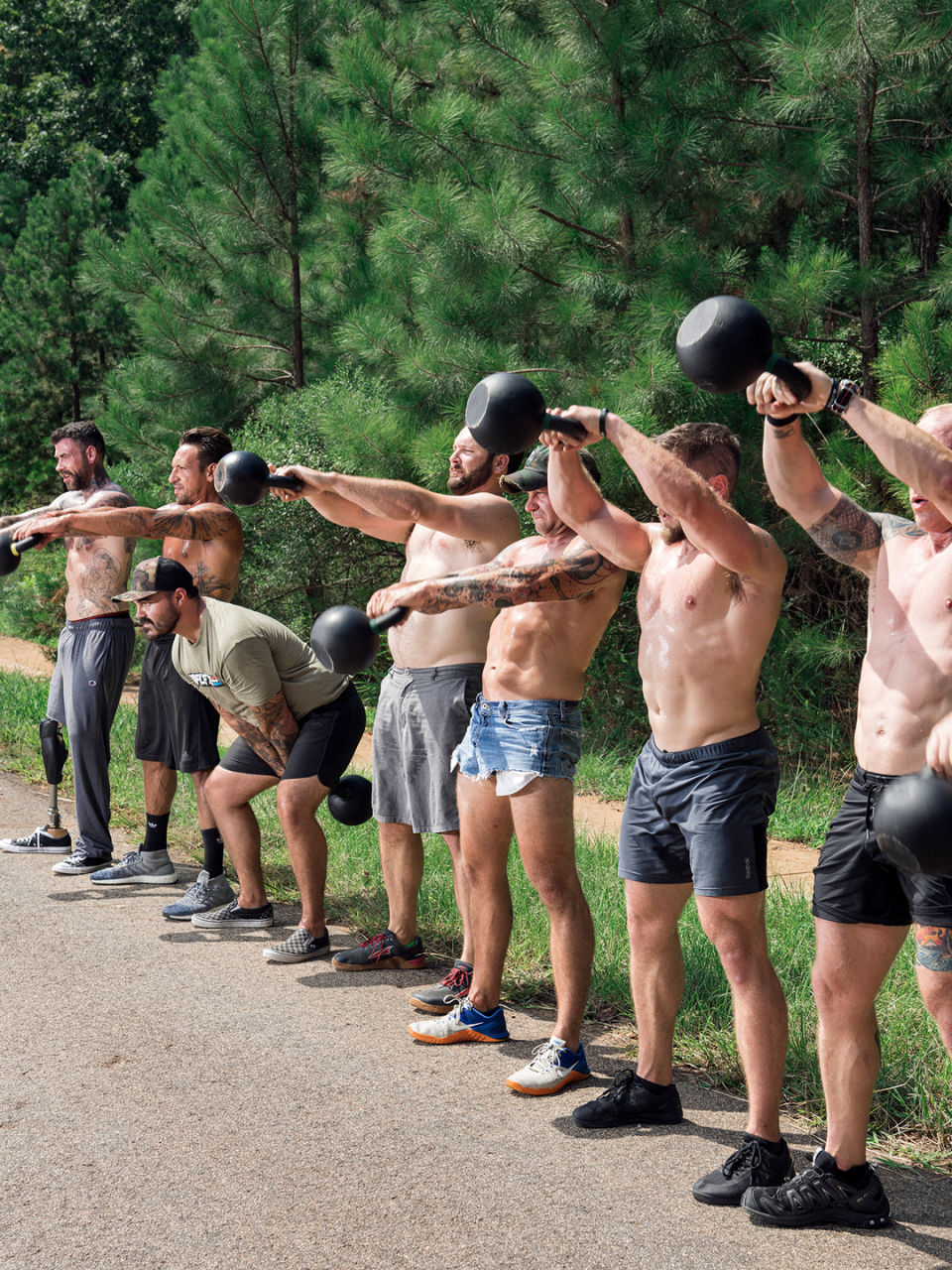
In 2014, Greg went on a deer-hunting retreat with a nonmilitary friend named Aron Woolman, a successful Wall Street trader then in his mid-30s. They’d spent the weekend discussing the problems with military fitness programming, and after talking with Woolman, an astute business mind, Greg decided they should do something about it.
So Greg, Bill, and Woolman did. They saw an opportunity in fitness plans that prepare men and women for Special Operations selection camps, which have low pass rates. Most other programs mimicked the hell of selection, following the “train how you fight” mantra, says Greg. Think daily miles of heavy rucking and anything else that sounded militaryish and awful. But while they zigged, Greg and Bill zagged. “If you throw on a 70-pound ruck and walk for 12 miles, you get tired pretty quick,” says Greg. “Then every step is sloppy, on uncontrolled terrain, while you’re weighted down, so the potential to twist an ankle or knee is extremely high.” If that happens, there go your chances of passing selection.
Greg’s and Bill’s experiences at selection told them that a better strategy is to strengthen all the muscles involved in rucking and to build an aerobic base. “If you can back-squat 400 pounds and run a respectable ten-mile time, you’re going to do well in the ten-mile ruck run,” says Greg. The three men put together a PDF of a selection-prep program, which included lots of military-specific strength and conditioning fundamentals but very little heavy rucking, and tossed a brand on the file: SOFLETE, a combination of SOF, the acronym for Special Operations Forces, and athlete. Then they uploaded it to the Internet.
“The PDF took off,” says Bill. It got a shocking number of guys through selection camps. “We were running SOFLETE as a small passion project, but by October of 2015 we realized that we should focus on running it as a business,” says Woolman, a laid-back type who acts as the CEO and “mom” of the company. The others—Kiesewetter, Briones, and Hueske—took notice, everyone started talking, and SOFLETE gained speed.
That initial PDF has evolved into more than 100 different programs based on your goal—building strength, endurance, or muscle, for example, or prepping for a hunt—all accessible on the SOFLETE app for $34 a month, making them easy to do on bases and in gyms around the world. They tick all the boxes a war fighter needs—raw strength, explosive power, all-day endurance, and killer speed—while sneaking in, through nutrition coaching and extended mobility warmups and cooldowns, the never-say-die durability that helps modern servicemen and -women survive deployment after deployment and thrive in kinetic modern warfare.
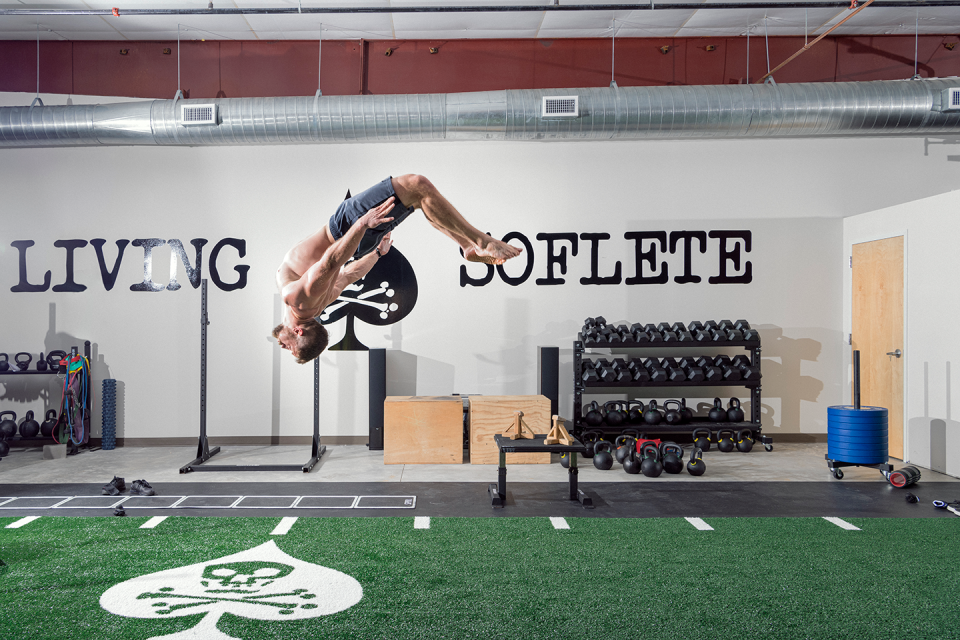
Durability is critical for today’s Spec Ops personnel, as America increasingly leans on its elite war-fighting teams. Special Operations are now active in over 90 countries, and members of the House and Senate Armed Services Committees have even testified that the constant deployments are taking a physical and mental toll.
“SOFLETE workouts are hard, and we encourage people not to flip the idiot switch, but the recovery components are key,” says Kiesewetter, the funny brother of the group, who, thanks to his sleeves of military-style tattoos, appears in many SOFLETE videos. This idiot-switch-free approach to holistic fitness training is why this band of irreverent servicemen has amassed a hell of a following. The company has grown 2,000 percent since the end of 2015.
Each training program is like a symphony, every workout building to a larger goal. The 12-week Juggernaut program, for example, stresses developing muscle and power. It does this via compound lifts like the deadlift, back squat, and power clean. But it doesn’t neglect durability and stamina. Juggernaut has plenty of mobility and accessory work, plus biweekly days featuring sessions such as eight sets of 400-meter runs at a slow pace. Harmonized programs are common in professional sports, but not every military-fitness company has caught on.
Each SOFLETE program goes through the meathead brain trust: six combat-experienced Special Operations personnel who have an alphabet soup of fitness credentials. This hive mind sets them apart. Many other military-style programs are written by a single guy. And that guy may be a fitness pro who has no military background, which oftentimes causes him to measure success by a serviceman’s numbers in the gym, rather than his performance at war.
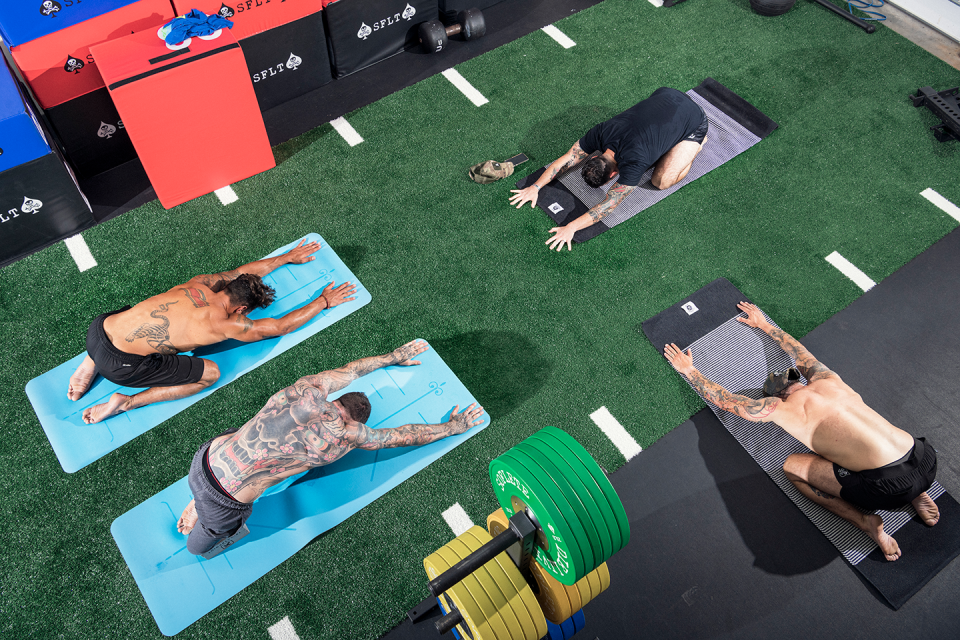
That gym-based mind-set is dangerous. Because the more you push your performance limits, the greater the toll your training takes on your body. “SOFLETE prioritizes durability over absolute performance,” says Kiesewetter. Having enough fitness and durability is what allows you to stay out of harm’s way mission after mission. “With SOFLETE programming, you’re probably going to have to give up being the absolute biggest, fastest, strongest guy in your unit,” says Hueske. “But you will be third or fourth best in all those metrics over 20 years, while the guys who are number one keep rotating because they get injured.”
The group is cranking out the strength exercises before we move on to a stamina phase, which will entail doing as many rounds of 1,000-meter rows, 400-meter runs, and 400-meter farmer’s walks as possible in 13 minutes. Beyond the SOFLETE brain trust, there’s John Warren, an Army sniper; Mike Crellin, a police officer in Houston; Nolan Bastien, a firefighter in Indianapolis; and Phil Sussman and Dave Ploch, of different wings of Army Special Operations. These men are the converted. SOFLETE programming helped with the back pain that Bastien, 39, had due to subpar exercising programs and overtraining. That’s made him, his team, and the public safer. “I’m a more functional part of my crew,” he says.
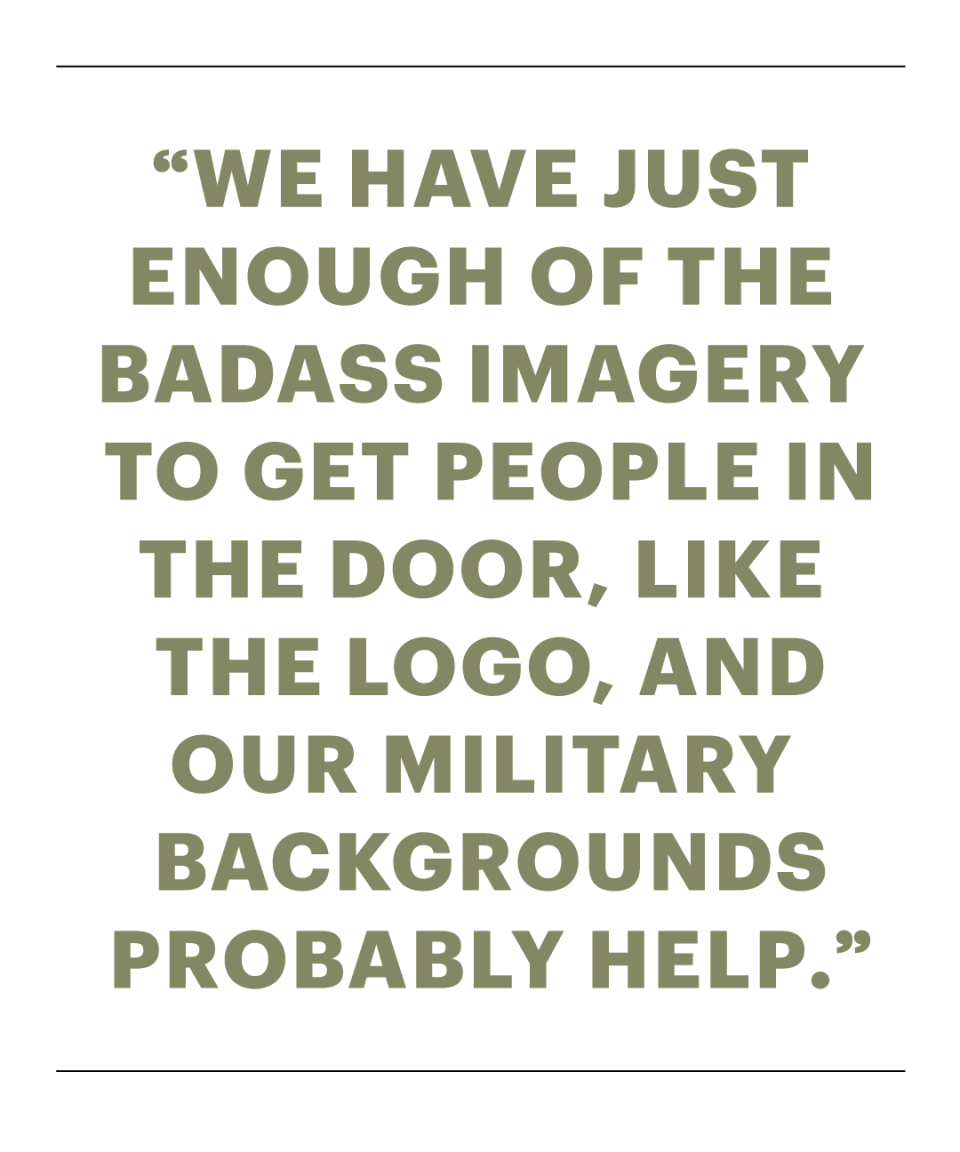
The app’s nutrition programming helped Crellin, 37, lose 80 pounds and Warren, 30, eat well consistently. The app calculates your carb, fat, and protein needs based on your size, goal, and activity level. Not into counting macronutrients? Cool. Who is? The app also spits out a day’s worth of recipes that fit exactly into your macros. The recipes are complex—for example, pork chop with veggie-loaded orzo or chicken with sweet-potato mash and roasted sprouts—but if you’re kitchen-phobic, each week you’ll prep meals on Sunday and eat the same meals every other day.
When the workout ends, we form a sweaty circle around Sussman, who found yoga after an armored-vehicle accident sidelined him with pain and depression. He leads us through a series of poses that hit areas that tend to be particularly tight in war fighters and desk jockeys alike. Ploch digs the yoga part. He enlisted in 1996, has been deployed 14 times, and may be seeing more. “I now know I have to work out smarter to keep mobile and flexible,” he says. “SOFLETE stuff is keeping me in the fight.”

WE COMPLETE THE LIFTING part of the workout and now the gym is functioning as a full-fledged content studio, like Peloton but with less spandex and spinning. I’m curious to finally learn what the heck the logo—which is stamped on everything from bumper plates and med balls to T-shirts and water bottles—symbolizes. First, though, Hueske has set up lighting and is interviewing Bastien for a series on how first responders have benefited from SOFLETE. “We’re trying to reach out to more guys with jobs like those,” says Kiesewetter. “And average guys.” They’ll do that by holding more events like the one in Joshua Tree and by expanding the app.
SOFLETE is still a young company experiencing growing pains. The current version of the app, for example, offers a ton of programs, and it’s not clear how, say, one 80-plus-day strength program differs from the 14 other programs. In January, it plans to launch the app 2.0, which will include a more streamlined process of putting users into the programs they need. You’ll be able to link it to an Apple watch, and your training, recovery, and nutrition will automatically scale based on recovery metrics from the watch. “Anyone can comply with a three-month exercise program,” says Kiesewetter. “The challenge is how to make them comply with recovery practices as well.”
Hueske, the brand’s media maven, elaborates. “The word yoga has so long been synonymous with, like, leaf eating,” he says. “To get guys in my unit to do stuff like this, we’d call it ‘tactical stretching.’ ” So it is with SOFLETE, which often has to shape its message for testosterone-addled men who would perhaps rather not tread the same workout territory as their girlfriend.
We move off the turf to some couches. I’m spent and feel like I’ve put in hard work, but I’m confident I’ll be able to walk down the stairs tomorrow. I sip a shake of SOFLETE “Fruit Hoops” cereal-milk-flavored protein powder and water as the guys talk about SOFLETE products. “We wanted a protein powder that tastes like the milk that’s left after you eat a bowl of cereal,” says Kiesewetter. They also sell a cinnabun-flavored protein powder and a melatonin, chamomile, and lavender nightcap called Teddy Bear Night Night.
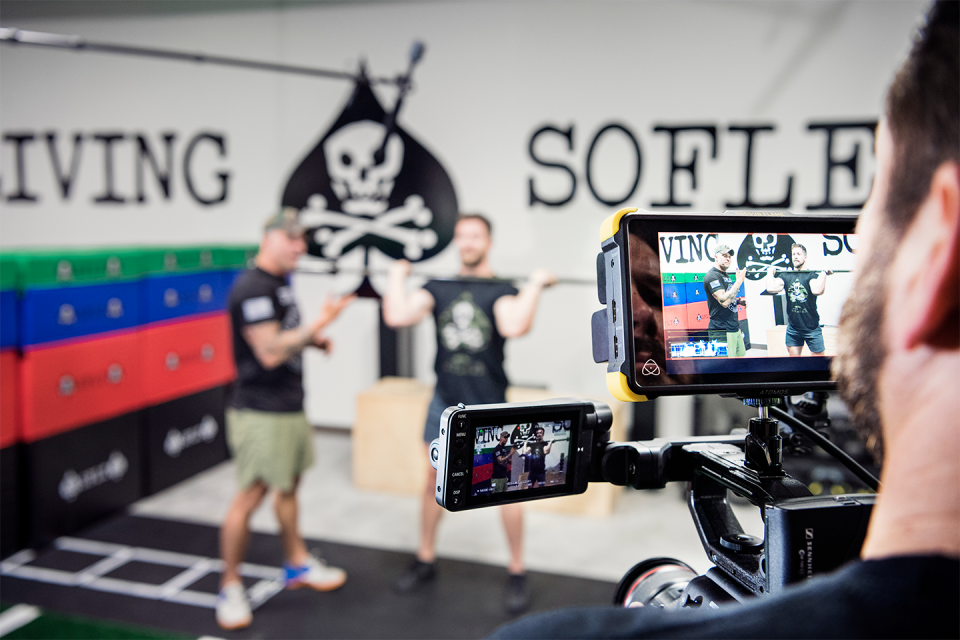
Each guy is wearing some version of a SOFLETE T-shirt, which all feature the brand’s logo: a spade with a skull and two crossbones. The logo is also prominent in the brand’s dieliving.com stories. But what is it, exactly? An homage to the “death cards” that American troops would leave on Vietcong they’d killed in battle during the Vietnam War.
When that first PDF dropped, they shared it with friends and family on Facebook, says Woolman, where the logo and the mission caught the eyes of service personnel, law enforcement, first responders, and people interested in military fitness. “We have just enough of the badass imagery to get people in the door, like the logo, and our military backgrounds probably help,” says Kiesewetter. “But then once people are in, it’s like, ‘Hey, here’s the yoga’—we give them the workouts and lifestyle advice they need.”
The vernacular of the instruction is also uniquely direct. Take, for example, a recent Instagram video about correct pullup form. Caption: “We’re here to help if your pullups are hot garbage.” Or the caption of a similar video about squats: “If your front squat is jank as fuck you need to watch this video.”
But sometimes that marketing humor borders on offensive. Take the description of a SOFLETE camo hat: “Whether you’re two steppin’ through Compton or playing IED hop scotch outside of Kabul, this snapback will drop every pair of panties within a six block radius.” SOFLETE also once sold a cologne called Flex Offender. “I spent two nights on the couch after my wife found out about that one,” says Woolman.
While SOFLETE is making real progress with fitness, it’s not always as on point when it comes to helping break down the stereotype that military guys aren’t the most culturally sensitive creatures. Some of that is the brand trying to maintain authenticity, writing product descriptions that mimic how Spec Ops guys talk in a team room. And some of the blowback may be a consequence of a way-too-woke culture that has an amplified voice in social media. Woolman says SOFLETE is evolving and that the more offensive stuff is held over from the beginning of the brand. “And I will say we’ve always been equal-opportunity offenders.”
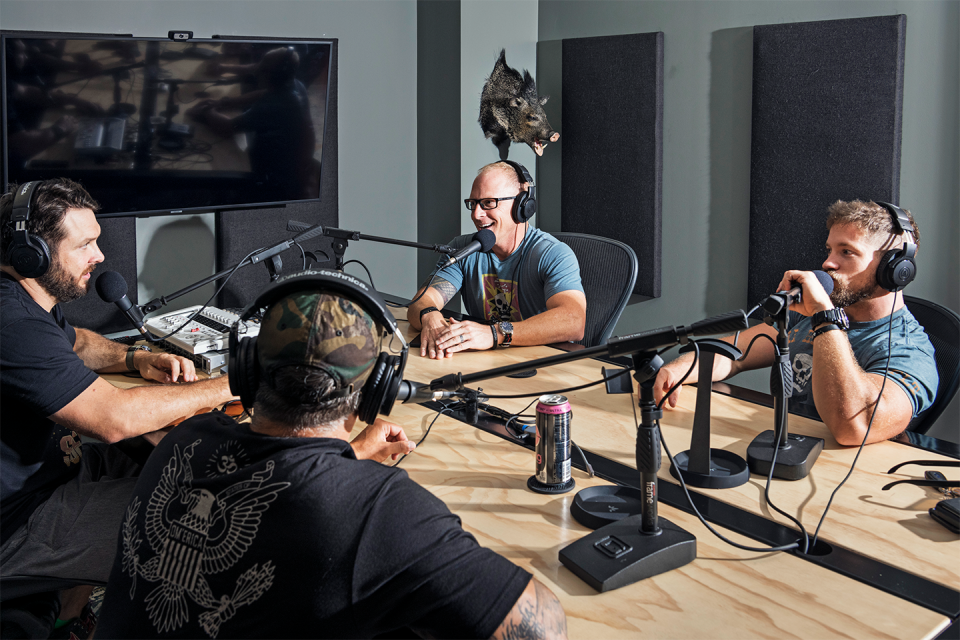
It’s a theme Kiesewetter takes up. “We all learned that that humor is a way to avoid uncomfortable situations,” he says, speaking of the awkwardness that not only a trained killer but any person with a Y chromosome might feel opening up to the softer side of life. Hueske adds, “And we just don’t take ourselves too seriously. Lots of other militaryish companies do.” They hope this makes SOFLETE videos and other content more accessible.
“There’s an uncanny valley of how badass someone is in the military,” says Hueske. “In my career, I’ve found that the most badass guys who’ve done the hardest stuff will never tell you about it. They never want to be recognized as badass.” As we sit around laughing, Goggins’s book, Can’t Hurt Me, comes up, and its message doesn’t resonate. Ploch (who, as a reminder, has deployed 14 times) smiles and says, “You can get hurt in this job.”
In 2017, a venture-capital firm approached SOFLETE. The team met a few Patagonia-vest-wearing finance types. Big money was on the line—enough to make SOFLETE’s founders rich. “They had just invested in another military brand, and they asked us, ‘What are you guys against?’ ” says Woolman. “We didn’t understand the question. So they said, ‘Well, are you against hipsters, liberals, people for gun control? What are you against?’ We said, ‘We’re not against anything. We’re for helping people, for being authentic, and for pushing your personal boundaries and living your best life.’ ”
And then the SOFLETE guys all went to practice yoga.
You Might Also Like

